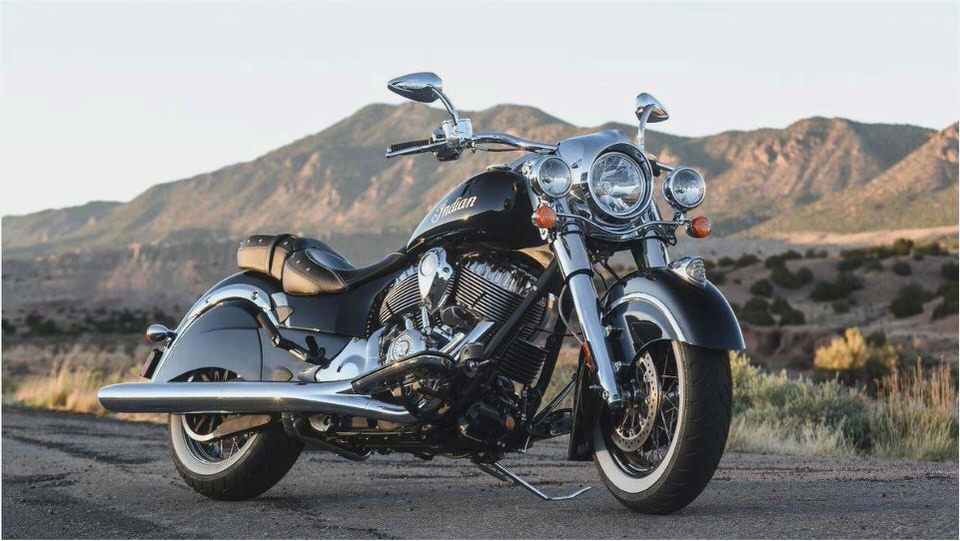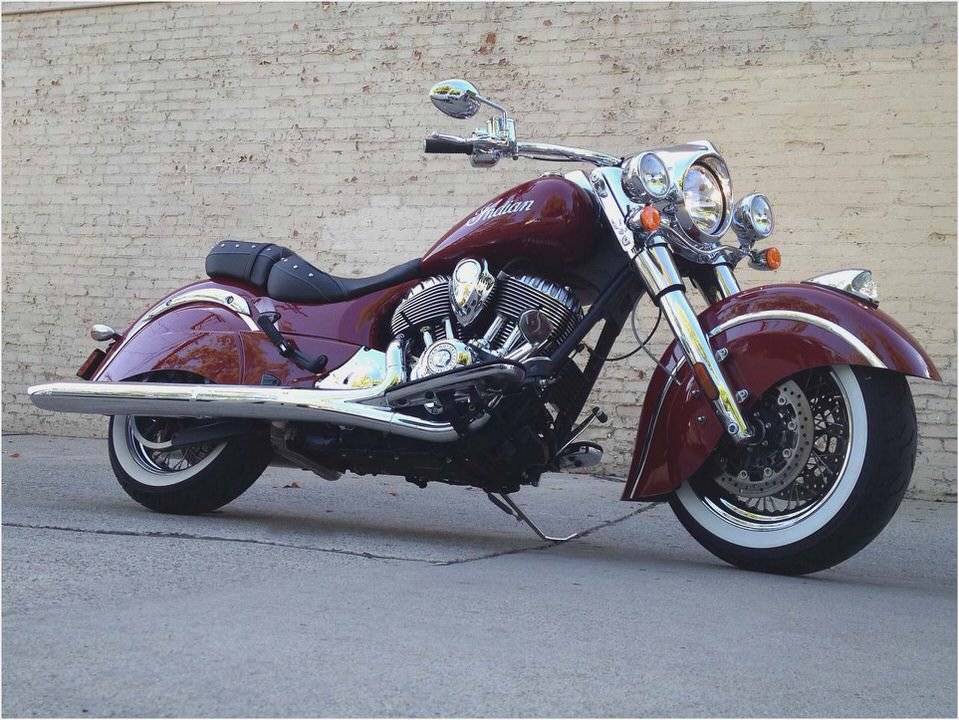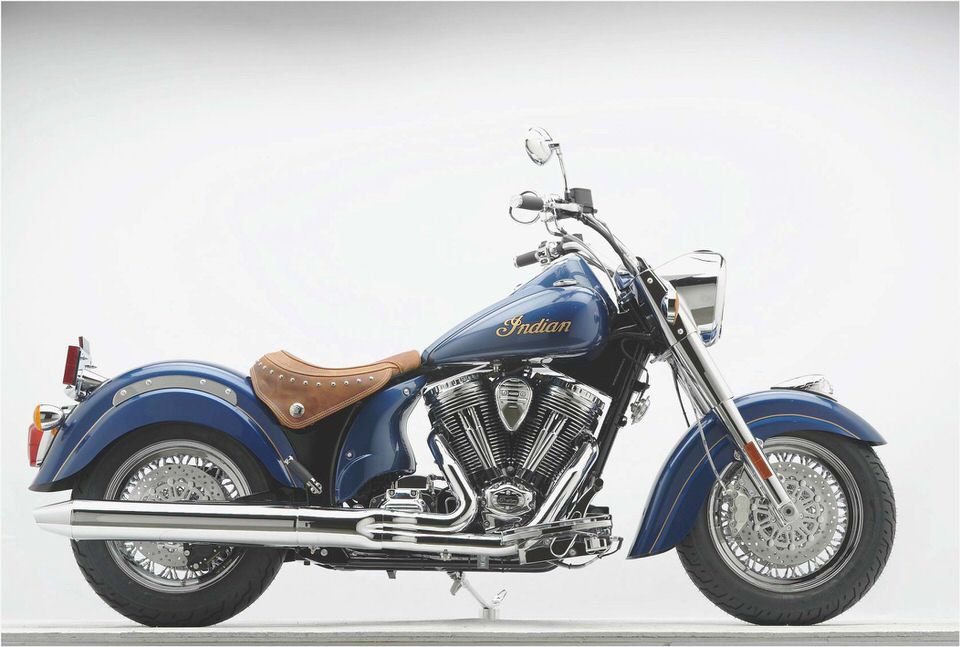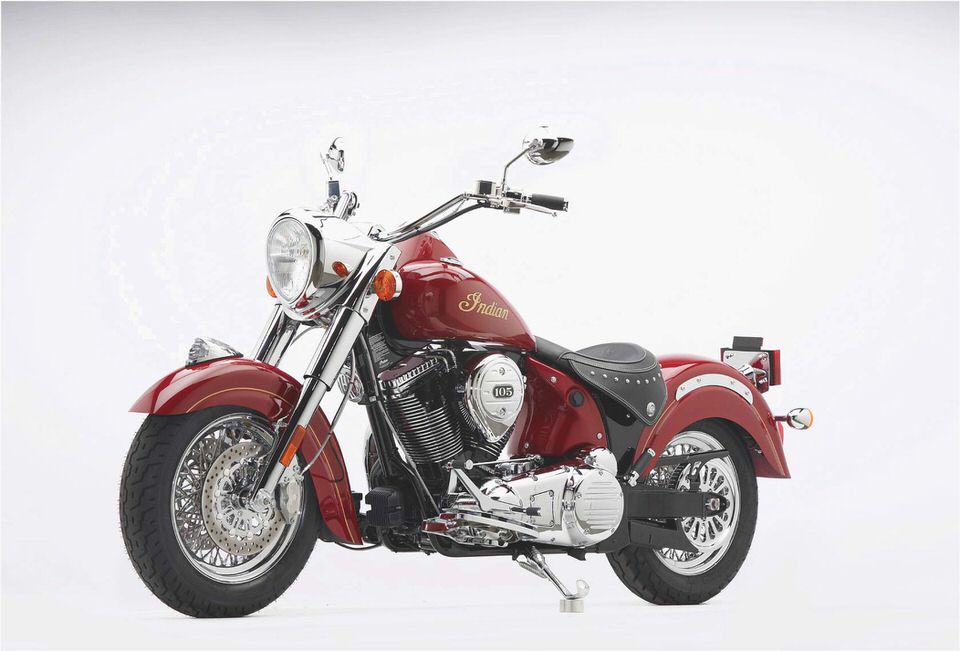
2014 Indian Chief Classic, Vintage and Chieftain: MD First Ride (Part 2)
Chief Classic
My reaction was largely disappointment when I saw the first ground-up redesign of the Indian Chief by new owner Polaris as it rolled onto the stage for its debut at Sturgis, South Dakota last week. The history of this brand, before it stagnated, and occasionally went into cardiac arrest, had so much cutting-edge design and race-winning performance, I had hoped that the new custodian would pay homage to both the aesthetic and the performance past of the marque by morphing the heir into something light, nimble and classic all at once. Incorporating at least something akin to the spare, elemental profile of the earlier Indians that found success on board tracks and the Isle of Man.
This image is taken directly from an Indian slide presentation, and doesn’t necessarily reflect the opinion of the author.
Fortunately for Polaris shareholders, nobody consulted me when the new Chief was designed. As I stood in the sea of Harley faithful at the unveiling, there was no sense of disappointment surrounding me. Instead, there was fascination … even the slightest hint of aspiration.
This massive family, with the collective purchasing power of a small nation, had witnessed the birth of a blood relative for a change, not a foreign pretender … or so it seemed.
Another slide from an Indian presentation.
Riding the new Indians at the historic rally (which was founded by an Indian Motorcycle club in 1936, according to Polaris) over the next several days revealed not only the open arms of the Harley-Davidson clan, but their warm embrace. Every time I parked a Chief, I was approached by excited Harley riders, many of whom asked permission to take a picture of the Chief, with or without me in the frame, or to have their picture taken with the bike.
These were both blue-collar enthusiasts and “RUBs”. This told me that, so long as the new Chief, in all its iterations, offered a riding experience familiar to the H-D faithful, Polaris had the best chance yet to take significant market share from H-D.
Of course, “familiar” is one thing, while an enhanced riding experienced was Indian’s goal, and part of its somewhat softly spoken ambition to make Indian not only a comfortable alternative to Harley, but an aspirational brand. Did it succeed?
Underlying the classic exterior of the new Chief platform is a thoroughly modern engineering exercise. At least, as thoroughly modern as it can be without violating the single technical requirement of the target market … air cooling. The frame feels like the stiffest available in the segment.
It is a unique modular design incorporating aluminum castings, forgings and steel elements (the rear fender is even used as a structural member). Near the steering head the frame triangulates and serves double duty as part of the air box.
This stiff foundation holds the gorgeous Thunder Stroke 111 engine. which we devoted a separate story to months ago. A classic two-valve push-rod design with the trademark downward firing exhaust, the top end is cooled exclusively by air drawing heat away from the massive fining surrounding the cylinders and heads. A separate oil cooler sits as inconspicuously as possible, aiding reliability and lengthening oil change intervals.
Counterbalanced, fuel injected and driven-by-wire, the unit delivers a maximum of 119 ft/lbs at 3,000 rpm through a six-speed transmission via a massive, overbuilt clutch. Power reaches the rear wheel by a toothed belt.
Suspension includes a progressive linkage for the single rear shock, for greater travel and a smoother ride. The Chiefton hard-bagger shock incorporates pneumatic preload adjustment. Front brakes are dual rotors and four-piston calipers, with a single two-piston arrangement in the rear.
Curb weight hovers just over 800 pounds for all three models.
You may have seen photos of me riding all three Chiefs in Part 1 of this report. including the Classic, the Vintage (with its striking tan leather), and the hard bag Chieftain. Interestingly, Indian gave the Chieftain more aggressive steering geometry and a shorter wheelbase than its siblings. Each of the three Chiefs features a well-crafted genuine leather seat and tank strap, as well as cruise control, anti-lock brakes, auxiliary driving lights and a split dual exhaust.
Not to mention more chrome than you will find on any stock cruiser.
The Classic and the Vintage feature laced wheels and whitewall tires, while the Chieftain has cast wheels and blackwalls. The Vintage has its leather saddlebags and quick-release removable windshield, while the Chieftain gets a power windshield (the only one we know of on a fork-mounted fairing), 100 watt audio system, bluetooth and tire pressure monitor. All three bikes feature a key fob with proximity sensor that allows you to start the bike without a key.
Chief Vintage
The hard luggage on the Chieftain can be locked and unlocked remotely, as well as removed relatively easily.
All three bikes are certainly heavy, but they carry their weight relatively low and lift off their side stands easily. Low speed handling (parking lot speeds) can be cumbersome, particularly for the long wheelbase models, the Classic and Vintage. Once moving at moderate speeds, however, all three bikes handle with stability and predictability.
Suspension action on all three models was surprisingly good. Combining supple small bump absorption with a firmness that inspired confidence at higher speeds. There is no question that the suspension tuning on these bikes benefited greatly from the extremely stiff frame which does not flex and rebound like many (probably, most) steel framed cruisers.
There is a general sense of precision and predictability to the chassis as a whole. Very good stuff.
Indian chose relatively conservative steering geometry. As stated, the Chieftain has a shorter wheelbase and steeper steering head angle, but even it favors stability over flickability. The other two bikes are among the most stable motorcycles I have ever ridden, but they still roll relatively easily into sweeping corners and hold their line well (neither under-steering nor over-steering).
At 5’11″ tall, the ergonomics felt comfortable and not too stretched out. Taller riders might feel slightly cramped in fact, as each Chief places the rider closer to the cockpit than some of the competition. Another important ergonomic element on any cruiser, the heft and shape of the brake and clutch lever is hard to fault.
They are both beefy and pleasingly curved to fit your fingers.
The brakes offer plenty of power, but not a lot of initial bite. Given the target customer, they properly come on more gradually and predictably. We never experienced brake fade, although the crowded roads of Sturgis frequently prevented us from pushing the pace on twisty roads.

We experienced a remarkable, and pleasant, lack of wind buffeting behind the shields on both the Vintage and Chieftain. The Chieftain has the electrically adjustable windshield height with enough range to satisfy most riders. Like the Vintage, the Chieftain allows some air to enter below the screen to balance any back pressure on the rider.
We liked the seat shape of the Chieftain best, and understand that production units of the Classic and the Vintage will share the same design. The seat seemed firm enough to allow longer rides without too much discomfort setting in.
Despite some minor vibration through the floorboards, the engine overall is very smooth. It is also deceptively fast. Power comes on strong just above idle, and with nearly 120 foot/pounds of torque at 3,000 rpm, Indian claims a broad plateau of more than 100 foot/pounds torque.
With very little perceptible engine noise aside from the air intake and exhaust, the Indian makes some very beautiful music. I particularly liked opening the throttle aggressively down around 2,000 rpm, where the distinct power pulses coursed through my body as I heard the corresponding, pleasant thumps emitted by the intake/exhaust combo. A wonderful sensation, and a very important part of the cruiser experience that has been handled superbly by Indian.
Transmissions on big twins like these always seem to emit a relatively loud clunk as you change gears, and the Indian is no different. Despite this, gear changes were as easy and seamless as I could hope to expect from a box transferring this kind of torque. I didn’t miss a single shift in three days of riding.
The rear view mirrors vibrated enough to blur the image at higher rpm levels, and they were placed too close to my hands on the bars. Wearing gloves with knuckle protection, my throttle hand hit the rear view mirror on two of the bikes I rode before I spent considerable effort adjusting those mirrors further away.
Engine heat is generally well-controlled, and no worse than most big twins emit near the rider’s legs. Nevertheless, the rear cylinder head sticks out enough on the right side of the bike that you can rest your right knee against it and burn yourself. This only happened to me once (while at a stop with only my left foot down, and my right leg pressed against the bike), and the natural position of my right knee was some distance from the cylinder head while riding.
This wasn’t an issue that would prevent me from owning a Chief.
All three bikes are so stable that I think Indian could have been a bit more aggressive when designing the steering geometry. Even the Chieftain with its shorter wheelbase and steeper steering head, never felt quite as engaging as some competing models I have ridden on twisty roads. That ultra-stiff frame may contribute to a more muted feedback from the road.
Cruise control worked well on all of the bikes and in my limited time listening to the stereo on the Chieftain, its speakers seemed powerful and clear, and radio reception was good.
Overall, the new Chiefs have a very refined, quality feel to them. The power they put out is outstanding for stock tuning, and reminded me of the 110 cubic inch engines in the expensive Harley-Davidson CVO models I rode not too long ago. The fact that the stock Indian motor is 111 cubic inches seems to be more than a coincidence.
The new Indians are attractively priced given their quality, performance and stock features. The Classic is priced at $18,999, the Vintage at $20,999 and the Chieftan at $22,999. Comparably equipped Harley-Davidson models are several thousand dollars more expensive.
So Indian has come to the table with all the goods. The right brand for the market, and a product that should be more than satisfactory to most Harley-Davidson converts. The fit, finish and detailing of each component is near flawless. What’s left is the marketing effort of parent company Polaris to launch the all new Indian Chief models.
If the effort at Sturgis itself (where Indian had roughly 120 demo units, along with all of the units used by the assembled press) is any indication, Indian has come out swinging hard. We could be witnessing the beginnings of the first significant erosion of Harley-Davidson’s dominant market share by any competitor in recent memory.
Oh … and the styling has grown on me quite well. For additional details and specifications, visit Indian’s web site .



- Indian offers glimpse of next production Chief – Autoblog
- Vintage Indian Motorcycles – Collector Information Collectors Weekly
- Indian Chief Vintage India, Price, Review, Details, Specifications
- 2009 Indian Chief – Classic American Motorcycles – Motorcycle Classics
- The Indian Motorcycle Returns in All Its Glory – WSJ.com
